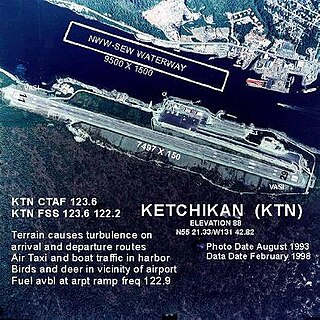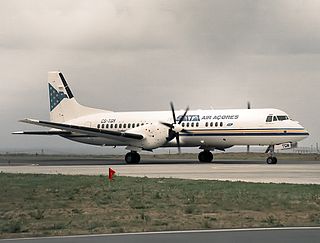
Pan Am Flight 759 was a regularly scheduled domestic passenger flight from Miami to San Diego, with en route stops in New Orleans and Las Vegas. On July 9, 1982, the Boeing 727 flying this route crashed in the New Orleans suburb of Kenner after being forced down by a microburst shortly after takeoff. All 145 on board, as well as eight people on the ground, were killed.

Pan Am Flight 214 was a scheduled flight of Pan American World Airways from Isla Verde International Airport in San Juan, Puerto Rico, to Friendship Airport near Baltimore, and then to Philadelphia International Airport. On December 8, 1963, while flying from Baltimore to Philadelphia, the Boeing 707-121 serving the flight crashed near Elkton, Maryland. All 81 occupants of the plane were killed. The crash was Pan Am's first fatal accident with the 707, which it had introduced to its fleet five years earlier.

Eastern Air Lines Flight 663 was a domestic passenger flight from Boston, Massachusetts, to Atlanta, Georgia, with scheduled stopovers at John F. Kennedy International Airport, New York; Richmond, Virginia; Charlotte, North Carolina; and Greenville, South Carolina. On the night of February 8, 1965, the aircraft serving the flight, a Douglas DC-7, crashed near Jones Beach State Park, New York, just after taking off from JFK Airport. All 79 passengers and five crew aboard died.

United Air Lines Flight 409 was a scheduled flight which originated in New York City, New York. The final flight destination was San Francisco, California, with stops in Chicago, Denver and Salt Lake City. The aircraft operating the service, a Douglas DC-4 propliner, registration N30062, crashed into Medicine Bow Peak, near Laramie, Wyoming, on October 6, 1955, killing all 66 people on board. The victims included five female members of the Mormon Tabernacle Choir and military personnel. At the time, this was the deadliest airline crash in the history of American commercial aviation. Another 66 lives had been lost earlier that year in the March 22 crash in Hawaii of a United States Navy Douglas R6D-1 Liftmaster military transport aircraft, and 66 had also died in the mid-air collision of two United States Air Force C-119G Flying Boxcars over West Germany on August 11, placing the three crashes in a three-way tie as the deadliest aviation incidents in 1955.

Juneau International Airport is a city-owned, public-use airport and seaplane base located seven nautical miles northwest of the central business district of Juneau, a city and borough in the U.S. state of Alaska that has no direct road access to the outside world. The airport serves as a regional hub for all air travel, from bush carriers to major U.S. air carriers such as Alaska Airlines.

Ketchikan International Airport is a state-owned, public-use airport located one nautical mile (2 km) west of the central business district of Ketchikan, a city in Ketchikan Gateway Borough in Alaska, that has no direct road access to the outside world or to the airport. The airport is located on Gravina Island, just west of Ketchikan on the other side of the Tongass Narrows. Passengers must take a seven-minute ferry ride across the water to get to the airport from the town.

Annette Island Airport is located on Annette Island in the Prince of Wales – Hyder Census Area of the U.S. state of Alaska. It is located 5 nautical miles (9 km) south of Metlakatla, Alaska. The airport was established as the Annette Island Army Airfield during World War II and initially served as a military airbase.

Alaska Airlines Flight 1866 was a regularly scheduled passenger flight operated by Alaska Airlines from Anchorage, Alaska, to Seattle, Washington, with several intermediate stops in southeast Alaska. The aircraft was a Boeing 727-100 with U.S. registry N2969G manufactured in 1966. On September 4, 1971, the aircraft operating the flight crashed into a mountain in Haines Borough, about 18 miles west of Juneau, Alaska, while on approach for landing. All 111 people aboard were killed. The subsequent investigation found that erroneous navigation readouts led the crew to descend prematurely. No definitive cause for the misleading data was found. It was the first fatal jet aircraft crash involving Alaska Airlines, and remained the deadliest single-aircraft accident in United States history until June 24, 1975, when Eastern Air Lines Flight 66 crashed. It is still, however, the worst air disaster in Alaska state history.
Taquan Air is the operating name for Venture Travel, LLC, an American regional airline headquartered in Ketchikan, a city in the southeastern portion of the U.S. state of Alaska. It operates domestic scheduled passenger and charter services. Its base is Ketchikan Harbor Seaplane Base, which shares the same harbor and airspace as Ketchikan International Airport. As per the United States Department of Transportation in a report dated August 2, 2010, Taquan Air is a "U.S. Certificated Air Carrier", and is 1 of 125 such carriers in the US.
Pan Am Flight 1104, trip no. 62100, was a Martin M-130 flying boat nicknamed the Philippine Clipper that crashed on the morning of January 21, 1943, in Northern California. The aircraft was operated by Pan American Airways, and was carrying ten US Navy personnel from Pearl Harbor, Hawaii, to San Francisco, California. The aircraft crashed in poor weather into mountainous terrain about 7 mi (11 km) southwest of Ukiah, California.
On July 28, 1943 American Airlines Flight 63 was flown by a Douglas DC-3, named Flagship Ohio, routing Cleveland-Columbus-Dayton-Cincinnati-Louisville-Nashville-Memphis, that crashed on the Louisville-Nashville sector about 1.6 miles (2.6 km) west of Trammel, Kentucky. The aircraft descended from 200 feet (61 m) until it struck trees, then slid across an open field and stopped in an upright position. Of the 22 people on board, 20 died. The cause of the crash was loss of control due to severe turbulence and violent downdrafts.

Wien Consolidated Airlines Flight 55 was a scheduled domestic passenger flight in Alaska that crashed into Pedro Bay on December 2, 1968, killing all 39 on board. The Fairchild F-27B aircraft was operated by Wien Consolidated Airlines and was en route to Dillingham from Anchorage, with three intermediate stops. The NTSB investigation revealed that the aircraft suffered a structural failure after encountering "severe-to-extreme" air turbulence. The accident was the second-worst accident involving a Fairchild F-27 at the time, and currently the third-worst accident involving the aircraft.
Pennsylvania Central Airlines Flight 105 was a regularly scheduled commercial flight between New York City and Birmingham, Alabama which crashed in the pre-dawn hours of January 6, 1946 while landing at Birmingham Municipal Airport, resulting in three fatalities.

On the evening of 30 November 1961, Ansett-ANA Flight 325, a service from Sydney to Canberra, Australia, operated by a Vickers Viscount 720, broke up in mid-air and crashed shortly after takeoff, when it encountered a severe thunderstorm. All 15 people on board were killed.

Paradise Airlines Flight 901A was a scheduled passenger flight from San Jose Municipal Airport to Tahoe Valley Airport, both within California, USA. On March 1, 1964, the Lockheed L-049 Constellation serving the flight crashed near Genoa Peak, on the eastern side of Lake Tahoe during a heavy snowstorm, killing all 85 aboard. After the crash site was located, the recovery of the wreckage and the bodies of the victims took most of a month. Crash investigators concluded that the primary cause of the accident was the pilot's decision to attempt to land at Tahoe Valley Airport when the visibility was too low due to clouds and snowstorms in the area. After aborting the landing attempt, the flight crew lost awareness of the plane's location as it flew below the minimum safe altitude in mountainous terrain. The pilot likely tried to fly through a low mountain pass in an attempt to divert to the airport in Reno, Nevada, and crashed into the left shoulder of the pass. At the time, it was the second-deadliest single-plane crash in United States history, and remains the worst accident involving the Lockheed L-049 Constellation.

SATA Air Açores Flight 530M was a Portuguese regional commuter flight operated by SATA Air Açores, that connected Ponta Delgada-João Paulo II Airport and Flores Airport, with an intermediary stop at Horta, on 11 December 1999. At 10:20 a.m., the British Aerospace BAe ATP, named Graciosa, while enroute to Horta, collided with Pico da Esperança, on the central mountains of the island of São Jorge, resulting in the deaths of all 35 people on board. It is also the deadliest aviation accident involving the British Aerospace ATP.

Alaska Airlines Flight 779 was a contract cargo flight operated on 21 July 1961 by an Alaska Airlines Douglas DC-6A that crashed short of the runway at Shemya Air Force Base with the loss of all six crew members on board.

Japan Air Lines Cargo Flight 46E was a scheduled cargo flight on 31 March 1993, operated by Evergreen International Airlines, on behalf of Japan Air Lines, from Anchorage International Airport, in Anchorage, Alaska, to O'Hare International Airport, in Chicago. After departure, while climbing through 2,000 feet, the pylon for engine two detached, causing the whole engine to fall off the wing. The pilots managed to land the 747 back at Anchorage without further incident.

Northwest Orient Airlines Flight 324 was a military charter flight from Haneda Airport to McChord Air Force Base. On the morning of January 19, 1952, the flight crashed into Hecate Strait in British Columbia, Canada, while making an emergency landing at Sandspit Airport. All three crew members and 33 of the 40 passengers were killed, making the flight the third-deadliest aviation accident in Canada at the time.















